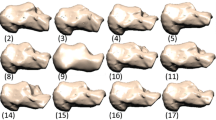Abstract
Compression garments due to their numerous medical applications have been recently attracted to be mechanically analyzed for their compression mechanism. Predicting the pressures applied to musculoskeletal tissues supported by these garments is a good solution for doing such analyzing which could be simply achieved by the help of finite element method. In this paper, the main aim was investigating the structural effect of knitted compression garments used for supporting the body lower-limb musculoskeletal system. Compression garments of weft knitted rib structure containing elastane yarn were prepared according to the leg’s dimensions of a healthy 27-year old person. Using Kikuhime measuring device, experimental values of the applied pressure were measured in order to be compared with theoretical results. For developing a three-dimensional biomechanical model for the leg system supported by compression garment, images form computed tomography scanning methodology was used. Tensile properties of an elastane yarn as the basis for studying the compression garment’s mechanical behavior were experimentally measured and then simulated in Abaqus software as a linear viscoelastic material. The results were then applied to multi-scale modeling technique in order to simulate mechanical behavior of the knitted fabric and the compression garment thereof. Combination of both experimental and theoretical results was applied to simulate interactions between the leg and the compression garment. The results indicated that the pressure values simulated by finite element method were predicted with the maximum mean error of 19.64 % and total error mean of 12.29 % compared to experimental results. Small difference between the measured and simulated values was observed for tibia and fibula because of their low soft-tissue volume. The proposed model enables the specialists to present compression garments based on the patient’s needs and physician prescription which generate the optimal treatment.
Similar content being viewed by others
References
P. Rohan, P. Badel, and B. Lun, Ann. Biomed. Eng., 43, 314 (2016).
K. Kelly, C. Johnson, and L. Dunne, Physiol. Rep., 7, 1 (2019).
F. Chassagne, J. Molimard, and R. Convert, Ann. Biomed. Eng., 44, 3096 (2016).
R. Liu, X. Guo, and T. T. Lao, Text. Res. J., 87, 1121 (2017).
F. Chassagne, J. Molimard, and R. Convert, Ann. Biomed. Eng., 43, 2967 (2015).
S. Anand, K. Govarthanam, and D. Gazioglu, J. Text. Inst., 104, 661 (2013).
Z. Jin, Y. Yan, and X. Luo, J. Fiber Bioeng. Informat., 1, 217 (2008).
D. Gupta, R. Chattopadhyay, and M. Bera, Indian J. Fibre Text. Res., 36, 415 (2011).
M. Trenell, K. Rooney, and C. Sue, J. Sport Sci. Med., 5, 106 (2006).
J. Tarrier, A. Harlanda, and R. Jonesa, ISEA, 3349 (2010).
X. Dai, R. Liu, Y. Li, and M. Zhang, Comput. Text., 55, 301 (2007).
L. Hong, C. Dongsheng, and W. Qufu, Text. Res. J., 81, 1307 (2011).
X. Zhang, K. Yeung, and Y. Li, Text. Res. J., 72, 245 (2002).
Y. Li, X. Zhang, and K. Yeung, J-STAGE, 59, 12 (2003).
K. Yeung, Y. Li, and X. Zhang, J. Text. Inst., 95, 59 (2004).
R. Liu, Y. Kwok, Y. Li, and T. Lao, Fiber. Polym., 7, 389 (2006).
R. Dan, X. Fan, and Z. Shi, J. Text. Inst., 107, 72 (2016).
H. Rodel, A. Schenk, and C. Herzberg, Int. J. Cloth. Sci. Tech., 13, 217 (2001).
L. Wang, M. Felder, and J. Y. Cai, J. Fiber Bioeng. Inform.4, 15 (2011).
N. Gokarneshan, Biomed. J. Sci. Tech. Res., 1, 806 (2017).
J. Rhie, Family Enviro. Res., 30, 1 (1992).
M. S. Jung and D. H. Ryu, Korean Assoc. Human Eco., 11, 79 (2002).
J. Seon S. Mee, S. Lee, and M. J. Park, Fashion Text., 2, 22 (2015).
L. Wang, M. Felder, and J. Cai, J. Fiber Bioeng. Inf., 4, 15 (2011).
O. Troynikov, E. Ashayeri, and M. Burton, ISEA, Procedia Eng., 2, 2823 (2010).
B. Sari and N. Oglakcioglu, J. Ind. Text., 47, 1 (2016).
J. Hill, G. Howatson, and K. Someren, Br. J. Sports Med., 48, 1340 (2014).
M. Datta, B. Behera, and A. Goyal, J. Text. Inst., 48, 1 (2019).
S. Ng and C. Hui, Text. Res. J., 71, 275 (2001).
E. Maklewska, A. Nawrocki, and J. Ledwon, Fibres Text. East. Eur., 14, 11 (2006).
S. Vassiliadis, Indian J. Fibre Text. Res., 32, 62 (2007).
M. Abghary, H. Hassani, and R. Jafari, Fiber. Polym., 17, 795 (2016).
E. Ghorbani, H. Hasani, and R. Jafari, J. Text. Inst., 110, 724 (2019).
T. D. Dinh, O. Weeger, S. Kaijim, and S. K. Yeung, Compos. Part B, 148, 81 (2018).
O. Weeger, A. H. Sakhaei, Y. Yi, T. Yu, H. Quek, T. L. Lee, S. Yeung, S. Kaijim, and M. L. Dunn, Appl. Compos. Mater., 25, 797 (2018).
R. Hessami, A. Alamdar Yazdi, and A. Mazidi, J. Compos. Mater., 53, 3201 (2019).
S. Hamedi, H. Hasani, and S. H. Dibajian, J. Compos. Mater., 51, 1887 (2017).
A. Dixit, H. Singh Mali, and R. K. Misra, Procedia Eng., 68, 352 (2013).
D. Liu, D. Christe, B. Shakibajahromi, D. Liu, D. Christe, B. Shakibajahromi, C. Knittel, N. Castaned, D. Breen, G. Dionc, and A. Kontsos, Inter. J. Solids Struct., 109, 101 (2017).
J. Rice, S. Cowin, and J. Bowman, J. Biomech., 21, 155 (1998).
Author information
Authors and Affiliations
Corresponding author
Rights and permissions
About this article
Cite this article
Ghorbani, E., Hasani, H., Nedoushan, R.J. et al. Finite Element Modeling of the Compression Garments Structural Effect on the Pressure Applied to Leg. Fibers Polym 21, 636–645 (2020). https://doi.org/10.1007/s12221-020-9542-3
Received:
Revised:
Accepted:
Published:
Issue Date:
DOI: https://doi.org/10.1007/s12221-020-9542-3




